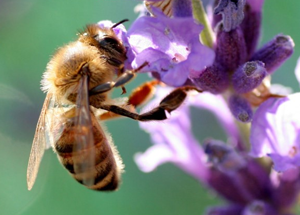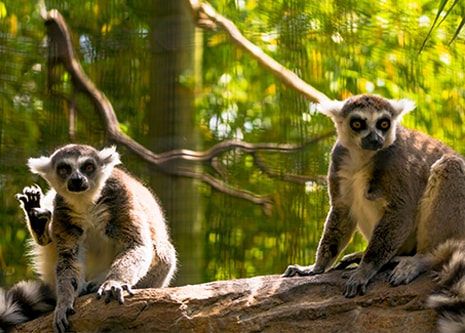
- VisitSupport Happy HollowDONATE TODAYExploreSupport Happy HollowDONATE TODAYLearnSupport Happy HollowDONATE TODAYSupport
-
Today's Hours: 10:00 am to 5:00 pm
Zoo in the HollowEuropean honey bee

Scientific name: Apis mellifera
Family: Apidae
Order: Hymenoptera
Class: Insecta
Range: Originally Europe, Asia, and Africa; now worldwide.
Habitat: Grassland, Temperate and Tropical Forest, Urban
Lifespan: Queen: 3 to 4 years; worker: 4 to 5 months; drone: 2 to 4 monthsWhat do they look like?
Like all insects, honey bees have six legs and three main body parts: the head, thorax and abdomen. This species has two transparent wings and characteristic black and yellow stripes on the abdomen. All three body segments are covered in hair-like chitin (a hard substance found in the exoskeletons of most insects), giving the honey bee a furry appearance. The head also has two large compound eyes and two short antennae.How do they behave?
Honey bees live in social groups called hives which are centered on a single queen. The queen is the only fertile female in the colony and rarely leaves the hive, except for short periods to mate or, if necessary, with the rest of the hive to form a swarm (a large collection of bees). The worker bees (sterile females) take care of the larvae, build new wax cells in the honeycomb, and forage for nectar and pollen. Worker bees have a barbed stinger, used to defend the hive. Drones are male bees without stingers, whose only duties in the hive are mating and temperature regulation, which is accomplished through vibrating.What do they eat?
Worker bees eat nectar and pollen. The workers digest the nectar then regurgitate it into a cell of the honeycomb back at the hive. The honey is dried by workers fanning their wings, and then capped with more wax to preserve it. This honey is used to feed the queen and larvae, and can sustain the hive over winter when few plants flower. At Happy Hollow, the bees find nectar and pollen throughout the Zoo and its surrounding areas. Bees in our observation hive are also sometimes supplemented with sugar water.How are they born?
The queen bee lays several different kinds of eggs, which result into different kinds of bees. The workers may also feed the larvae different kinds of food, depending on what kinds of bee the hive needs. For example, all bee larvae are fed on a special food called royal jelly. Later, most larvae are switched to honey; however, a larva which is continually fed on just royal jelly will grow into a new queen. Unfertilized eggs will develop into drones.What should you know about them?
Bees play a crucial role in nearly all ecosystems as pollinators. While collecting nectar, bees fly from flower to flower, brushing pollen from one blossom to another. This process fertilizes the flowers, which then produces a fruit, containing seeds for new plants. Many crops grown by humans also require bees to pollinate their flowers, including almonds and blueberries!Conservation
The European honey bee conservation status has not been evaluated by the International Union for Conservation of Nature . However, since 2006, bee populations have been declining worldwide (a term called colony collapse disorder). Scientists are still trying to understand the complex problems, which could include parasitic mites, fungal infections, viruses and pesticide use that are contributing to declining bee populations. Happy Hollow Park & Zoo is dedicated to the conservation of the European honey bee. Happy Hollow has its own colony of bees and supports the creation of native plant gardens to support pollinators of all shapes and sizes through its quarters for conservation program. You can help bees by buying honey from local beekeepers and including a clean water source in your garden.
Zoo on the Hill
Located across from the Keep-Around Carousel is the Zoo on the Hill. Learn about wildlife up close during daily meet-and-greets, leap like a lemur on the playground, brush and feed the goats,, or take a peek inside Doc’s Critter Care building and the Ranch House. Double-H Ranch features a combination of animal exhibits, including giant anteaters and red ruffed lemurs, as well chickens and domesticated animals that are docile enough to touch.
See Animals
Education Ambassadors
From camps and classes to scout badges and sleepovers, Happy Hollow education programs have something for everyone! The zoo education program offers a broad range of hands-on, engaging programs and public presentations featuring education ambassador animals. These encounters are designed to connect you to wildlife and the conservation of their habitats around the world.
See AnimalsVisit Us Today
Plan an unforgettable experience at San Jose’s family-friendly park and zoo.
Learn More